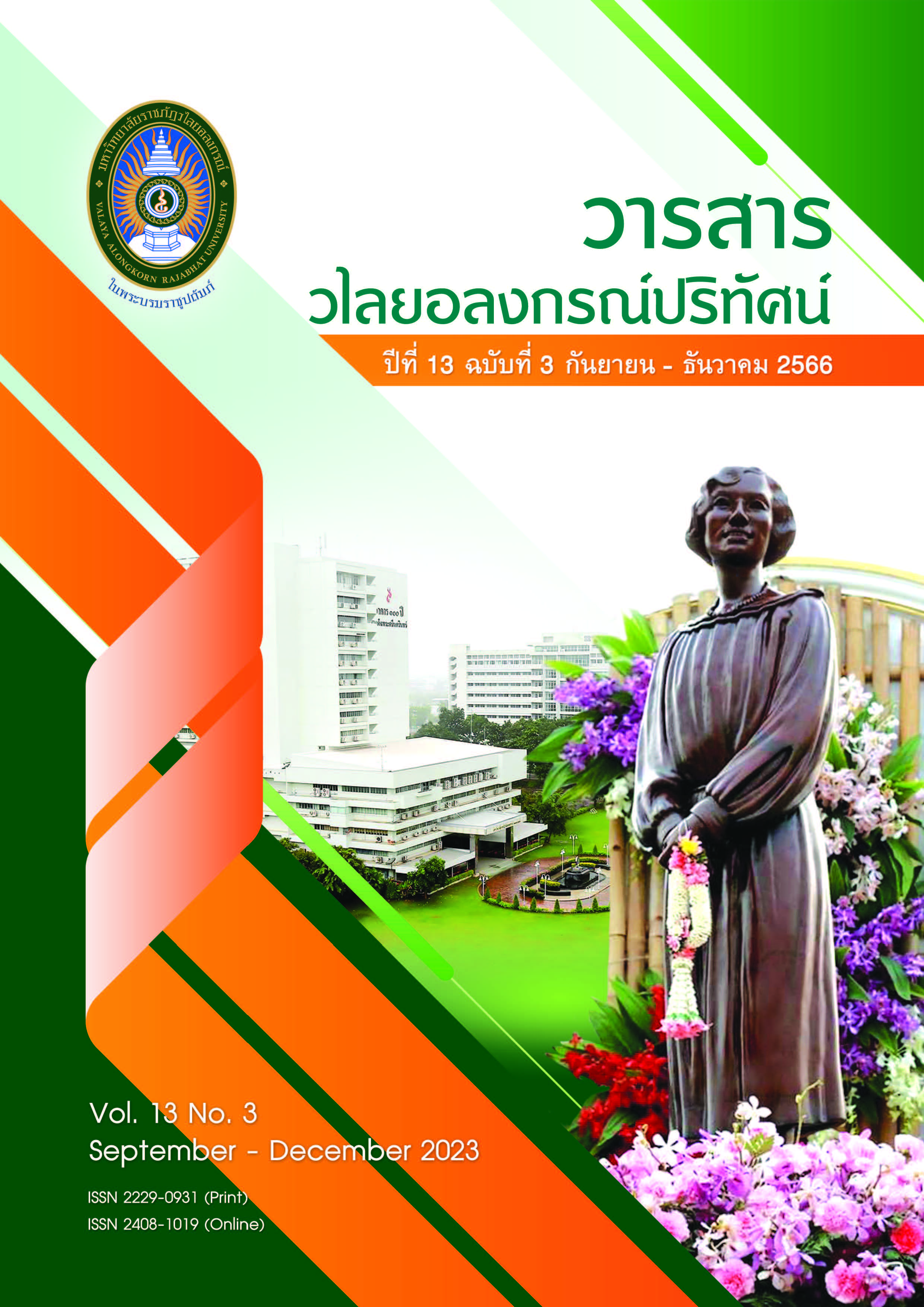การวิเคราะห์ตราสัญลักษณ์สโมสรฟุตบอลไทยลีก ตามแนวสัญญะวิทยา
คำสำคัญ:
ตราสัญลักษณ์, สัญญะวิทยา, ความหมายโดยนัยบทคัดย่อ
การวิจัยครั้งนี้มีวัตถุประสงค์เพื่อ 1) ศึกษาตราสัญลักษณ์ของสโมสรฟุตบอลไทยลีกตามแนวคิดเชิงสัญญะวิทยา 2) ศึกษารูปแบบและลักษณะที่ปรากฏในตราสัญลักษณ์ของสโมสรไทยลีก และ 3) เพื่อศึกษาแนวทางความต้องการตราสัญลักษณ์กีฬาของประชาชนจากการถอดรหัสสัญญะฟุตบอลไทยลีก โดยใช้การวิจัยแบบผสานวิธี ทำการศึกษาเชิงคุณภาพด้วยการวิเคราะห์ตราสัญลักษณ์ทีมฟุตบอลไทยลีก 1 จำนวน 16 ทีม วิเคราะห์เนื้อหาตามแนวคิดสัญญะวิทยา จากนั้นนำผลการศึกษาสร้างแบบสอบถามเพื่อทำการศึกษาเชิงปริมาณ ซึ่งผู้วิจัยจะใช้เป็นเครื่องมือในการเก็บรวบรวมข้อมูล และใช้การวัดผลครั้งเดียว จากกลุ่มตัวอย่าง จำนวนทั้งสิ้น 400 คน โดยใช้การสุ่มตัวอย่างแบบสะดวก จากนั้นจึงทำการวิเคราะห์ใช้สถิติการแจกแจงความถี่ และค่าร้อยละ
ผลการวิจัยพบว่า 1) สัญญะที่ปรากฏ จะแสดงความหมายโดยอรรถที่สื่อถึงความเป็นสโมสรนั้น ๆ และองค์ประกอบหลักส่วนใหญ่จะถ่ายทอดสัญญะความหมายโดยนัยในเชิงของความแข็งแกร่ง ผู้นำ และอำนาจ ซึ่งสะท้อนให้เห็นถึงบริบทของการแข่งขันกีฬาที่มีแพ้ชนะ ในด้านองค์ประกอบรอง จะถ่ายทอดความหมายโดยนัยที่สื่อถึงบริบท หรือความเกี่ยวข้องที่เชื่อมโยงกับสโมสร 2) ด้านรูปแบบและลักษณะที่ปรากฏในตราสัญลักษณ์ของสโมสรไทยลีกพบว่า รูปทรงของตราสัญลักษณ์ส่วนใหญ่ออกแบบเป็นทรงโล่ องค์ประกอบภายใน มักเป็นวัตถุสิ่งของ สีที่ใช้ส่วนใหญ่จะมีสีดำหรือสีส้มเป็นสีหลัก ซึ่งแสดงความหมายของการใช้กำลัง การท้าทาย การตัดสินที่เป็นธรรม การปกป้องและการเคลื่อนไหว ด้านบริบทความหมายทางสังคมวัฒนธรรมที่สะท้อนจากตราสัญลักษณ์ พบว่าปรากฏสัญลักษณ์ของประจำถิ่นที่เป็นบริบทของสังคมวัฒนธรรมอยู่ในตราเครื่องหมาย ให้ความหมายโดยนัยถึงความภาคภูมิใจ 3) แนวทางการออกแบบตราสัญลักษณ์สโมสรกีฬา พบว่า สีที่เหมาะสมในการออกแบบตราสัญลักษณ์สโมสร ได้แก่ แดง ขาว และดำ รูปทรงที่เหมาะสมคือ ทรงกลม และทรงโล่ ส่วนองค์ประกอบภายในต้องสื่อความหมายถึงองค์กรที่ชัดเจน
เอกสารอ้างอิง
กาญจนา แก้วเทพ. (2552). การวิเคราะห์สื่อ: แนวคิดและเทคนิค. (พิมพ์ครั้งที่ 4). กรุงเทพฯ: คณะนิเทศศาสตร์ จุฬาลงกรณ์มหาวิทยาลัย.
ไชยรัตน์ เจริญสินโอฬาร. (2542). วาทกรรมการพัฒนา: อำนาจ ความรู้ ความจริง เอกลักษณ์และความเป็นอื่น. กรุงเทพฯ: วิภาษา.
พงษ์ศักดิ์ ไชยทิพย์. (2546). เทคนิคการออกแบบงานกราฟิก. กรุงเทพฯ: ซีเอ็ดยูเคชัน.
รัยวินทก์ วิทวัสกุลวงศ์. (2558). การพัฒนาตราสัญลักษณ์ด้วยกระบวนการออกแบบเอกลักษณ์องค์กร กรณีศึกษา บริษัท วิลเลนดรอฟ จำกัด. วิทยานิพนธ์ศิลปศาสตรมหาบัณฑิต สาขาวิชาการจัดการภาครัฐและภาคเอกชน บัณฑิตวิทยาลัย มหาวิทยาลัยศิลปากร.
สมาคมฟุตบอลแห่งประเทศไทย. (2559). สรุปการแถลงข่าว “FA THAILAND ROADMAP 2017-2019". [ออนไลน์], เข้าถึงได้จาก: http://fathailand.org/news/60
สุธาวัลย์ สัจจสมบูรณ์ และธีว์วรา ไหวดี. (2561). กลยุทธ์การสร้างความแตกต่าง เครื่องมือในการสร้างความได้เปรียบทางการแข่งขัน. วารสารการบริหารการปกครองและนวัตกรรมท้องถิ่น. 2(3), 83-92.
Barthes, R. (1970). Writing Degree Zero and Elements of Semiology. Translated from the French by Annette Lavers and Colin Smith. Boston: Beacon Press.
Bottomley, P. A., Doyle, J. R. (2006). "The interactive effects of colors and products on perceptions of brand logo appropriateness". Marketing Theory. 6(1): 63-83. doi:10.1177/1470593106061263. S2CID 53464180.
Peirce, C. S. (1955). Philosophical writings of Peirce. New York: Dover Publications.
Saussure, F. (1959). Course in general linguistics. New York: McGraw-Hill Book Company.
Yamane T. (1967). Elementary Sampling Theory. New Jersey: Prentice-Hall INC.
ดาวน์โหลด
เผยแพร่แล้ว
รูปแบบการอ้างอิง
ฉบับ
ประเภทบทความ
สัญญาอนุญาต
ลิขสิทธิ์ (c) 2023 มนตรี วงษ์รักษ์

อนุญาตภายใต้เงื่อนไข Creative Commons Attribution-NonCommercial-NoDerivatives 4.0 International License.
ข้อความที่ปรากฏในบทความแต่ละเรื่องในวารสารวไลยอลงกรณ์ปริทัศน์ เป็นความคิดเห็นของผู้นิพนธ์แต่ละท่าน มิใช่เป็นทัศนะและมิใช่ความรับผิดชอบของกองบรรณาธิการจัดทำวารสาร และ
มหาวิทยาลัยราชภัฏวไลยอลงกรณ์ ในพระบรมราชูปถัมภ์


